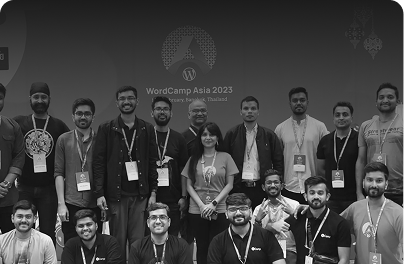HubSpot vs WordPress: Why architecture (closed or open) really matters
Comparing HubSpot CMS and WordPress on architecture quickly shows they were built for fundamentally different priorities. HubSpot’s CMS lives inside a proprietary, managed ecosystem, designed for tight marketing alignment, minimal maintenance, and ease-of-use, but with clear limits when you need to push beyond what HubSpot’s stack controls.
WordPress, on the other hand, is open-source and stack-agnostic by nature. It runs anywhere, connects to anything, and bends to fit any digital experience architecture, from traditional server setups to fully headless or composable DXPs.
This difference shapes everything from how you host, secure, and extend your sites to how your marketing, IT, and dev teams share ownership and evolve the platform together. In this chapter, we break down how each system’s underlying tech stack, deployment model, and customizability impact real-world enterprise realities: integration flexibility, developer freedom, and more.
Tech stack: Proprietary core vs open and extensible
HubSpot CMS runs on a proprietary codebase that only HubSpot engineers can modify. You get powerful tools built on that core, but you can’t see or change the underlying engine itself.
Unlike an open-source CMS (like WordPress and Drupal), HubSpot’s core is completely managed and closed.
- The rendering layer uses HubL (HubSpot Markup Language), a proprietary templating language unique to HubSpot.
- The data model relies on HubDB, a HubSpot-specific database for storing structured content and reusable data sets.
- Workflows, modules, and page templates all sit within HubSpot’s design manager, a browser-based IDE that governs how developers build and deploy CMS assets.
In contrast to HubSpot’s managed, proprietary environment, WordPress is open-source by design, built on widely adopted and developer-friendly technologies like PHP and MySQL, and standard web server stacks (Apache, NGINX, or containerized in the cloud).
You can own the codebase, database, and server environment (whether it’s hosted in-house, in your cloud, or with a managed enterprise host like WordPress VIP).
This gives your engineering team complete or significant freedom to shape your CMS’s underlying infrastructure.
Server and hosting: Fully managed vs flexible self or managed hosting
With HubSpot CMS, there’s no concept of self-hosting. Everything runs on HubSpot’s stack: the infrastructure, runtime, database layer, caching rules, and edge delivery are fully abstracted behind HubSpot’s service.
The simplicity of “HubSpot handles hosting for you” comes at the cost of deep architectural freedom. This is fine for smaller or mid-market setups, but for enterprises that want tight DevSecOps controls, scalable edge logic, and governance over where and how workloads run, HubSpot’s black-box hosting model is a real architectural constraint.
This closed-box design also directly shapes what’s possible for your digital experience stack. If you’re building a modern composable DXP, HubSpot’s CMS layer can’t truly adapt to it. Also, you can’t standardize your infrastructure stack across your different digital properties if you run multiple brand sites. Everything lives in HubSpot’s cloud, with little architectural portability.
Unlike proprietary SaaS CMSs (like HubSpot) where you have zero visibility or control over the underlying infrastructure, WordPress gives you two solid architectural paths:
- If you self-host, you have complete server-level access, which means you can configure your infrastructure stack exactly as you need. You can deploy custom caching, edge delivery, advanced security layers, and performance monitoring tailored to your workloads.
- If you use managed enterprise WordPress (like WordPress VIP), you trade direct access for a trusted SLA and managed DevOps, but you still get deep transparency. Enterprise hosts provide clear performance, uptime, and security visibility, so know how it’s all working.
This flexibility means you’re not forced to accept a one-size-fits-all infrastructure. You can design your architecture for regulatory compliance, custom security hardening, or global delivery at scale, all without being boxed into someone else’s cloud stack or waiting for proprietary vendor approvals. For IT and security teams, this control is a big part of why WordPress remains trusted for government, news, and highly regulated enterprise environments.
Codebase access: Closed core & controlled customizability vs truly open source
HubSpot’s CMS core is proprietary, fully owned and operated by HubSpot. You and your developers don’t have direct access to its underlying server-side code, database internals, or infrastructure layer.
At the architectural level, that means you can:
- Adapt within guardrails: Customize templates and modules using HubL, HubSpot’s proprietary templating language, and configure content types, forms, and workflows within its admin UI.
- Extend the frontend carefully: Build custom themes, use drag-and-drop modules, and embed client-side JavaScript for more dynamic behavior, but always within the constraints of HubSpot’s environment and security model.
- Integrate via APIs and middleware: Connect to external systems by leveraging HubSpot’s REST APIs, webhooks, or third-party connectors, but deep integrations often rely on passing data through external services you must build and maintain.
Instead of adapting the CMS itself, your team works around it, fitting custom logic into predefined boxes, building external layers for anything HubSpot’s core doesn’t natively support. That’s why many enterprises eventually pair HubSpot’s CMS with more open, flexible platforms, they want HubSpot’s ease for marketing, but need more control and extensibility elsewhere in their digital experience stack.
WordPress flips this model entirely. Its core codebase is open, licensed under the GPL, which means you (and your developers) have full visibility and control over how it works.
At the architectural level, that means you can:
- Modify the backend: Add custom post types, content structures, taxonomies, user roles, or editorial workflows that match your business logic.
- Extend the frontend: Create reusable design systems, custom block libraries, and modular themes that power consistent branding across global teams.
- Deeply integrate: Build plugins that connect your CMS to the rest of your DXP stack, automate flows, or enforce unique governance and security layers.
Instead of adapting to a vendor roadmap, your team can adapt the CMS itself — as your channels, teams, and tech evolve. That’s why major enterprises, publishers, and government orgs continue to bet on WordPress: its open architecture gives them a durable core they can flex and expand on their own terms.
Headless capabilities: Limited & evolving vs headless- and hybrid-ready
HubSpot CMS supports a basic headless delivery model through its Content API. This lets you query HubSpot content and render it on a decoupled frontend (like a React or Next.js site). However, this isn’t as flexible as WordPress’s REST/GraphQL ecosystem or custom headless frameworks.
So while you can go “hybrid” by using HubSpot CMS, you’re still bound by HubSpot’s API limits, rate caps, and data model. Deep custom headless implementations often hit limits fast.
In general:
- Works well for lightweight decoupling.
- Not practical for full composable DXP architectures at scale.
- For fully decoupled sites, many teams opt to pair HubSpot’s CRM with a separate headless CMS (like WordPress or Strapi). (By the way, HubSpot lists WordPress VIP as a top headless CMS!)
WordPress, in contrast, isn’t just a traditional monolithic CMS. It’s fully capable of powering headless and hybrid architectures thanks to its mature REST API and modern GraphQL implementations (via plugins like WPGraphQL).
So you can decouple the front end completely and serve content to any modern framework (React, Next.js, Vue, mobile apps, kiosks) all while keeping the editorial experience centralized and familiar for your content teams.
For hybrid scenarios, you can run parts of your site traditionally while offloading high-performance sections (like landing pages, campaign microsites, or app-like experiences) to a headless frontend.
This flexibility gives you true future-proof delivery. Your marketing teams stay productive in WordPress’s editor, while your development teams are free to innovate with the latest front-end tech stacks, performance frameworks, and deployment pipelines. This avoids lock-in to a single delivery model and lets you evolve your digital experience stack as your audience, channels, and technology shift.
Integrations: Integrated by design vs fully “integrable”
HubSpot’s Content Hub isn’t built for wide-open composability the way an open-source CMS like WordPress is. Instead, it’s integrated by design, within the HubSpot family.
Its core value is that your CMS, CRM, marketing automation, email, and sales tools live in a single, unified platform where data, permissions, and workflows are all natively connected. So you get a tightly coupled ecosystem where everything runs on HubSpot’s proprietary stack. Your CMS pages automatically connect with contact records, forms feed directly into pipelines, and marketing automation is ready out-of-the-box.
But when it comes to third-party integrations, your freedom is guided by how HubSpot’s ecosystem is designed. While you’ll find a well-supported App Marketplace with pre-certified integrations for common solutions, complex digital stacks aren’t supported. Large enterprises running complex digital experience stacks (with custom identity providers, CDPs, DAMs, microservices, or unique governance and compliance models) can find HubSpot’s “controlled composability” quite limiting.
Unlike proprietary CMS platforms like HubSpot that box you into their native modules and pre-approved apps, WordPress’s open architecture makes it inherently integrable.
So you can connect WordPress to any system in your enterprise stack, CRMs (like HubSpot! or Salesforce), CDPs, DAMs, ERPs, identity providers, search engines, personalization engines, and more. Thousands of pre-built plugins exist for common use cases, but if you need a custom connector, there’s a huge global developer pool ready to build it.
In short, your architecture stays flexible and future-proof. You’re never forced to adopt one vendor’s “all-in-one” approach, you choose the best tools for each layer of your DXP. Integrations don’t depend on vendor roadmaps or locked-down APIs. You get full freedom to evolve your marketing stack, expand into new channels, or swap in new systems as your business grows, all while keeping your CMS as a stable, open core that connects it all.
Conclusion: The real impact of your CMS architecture
Ultimately, choosing between HubSpot’s managed, closed-stack CMS and WordPress’s open, extensible core is about deciding where you need freedom and where you’re happy with convenience.
If your organization wants to move fast inside an all-in-one marketing hub, and is content to stay within HubSpot’s native boundaries, its tightly coupled architecture works well, especially for smaller digital teams with limited IT overhead. But the moment your enterprise needs deeper integrations, custom frontend experiences, or tight alignment with a larger composable DXP, all the convenience quickly become barriers and custom workarounds come with hidden cost and complexity.
WordPress flips this. It may demand more upfront investment in architecture, but you gain full ownership over the entire stack: hosting, code, integrations, and delivery. You can adapt the CMS to any infrastructure, plug it cleanly into any other system, and scale it globally under your security and compliance standards.
For enterprises prioritizing long-term control, cost predictability, and the ability to evolve with changing customer channels and tech stacks, WordPress’s open architecture gives you the flexibility that closed SaaS models can’t match, and that freedom pays off year after year.







